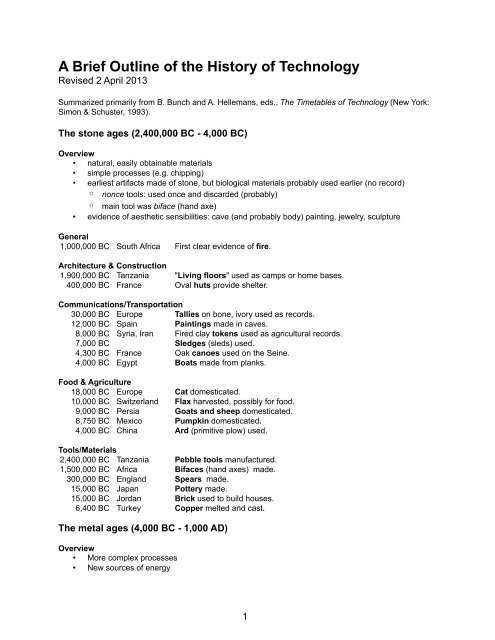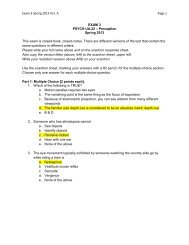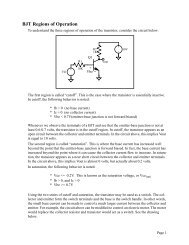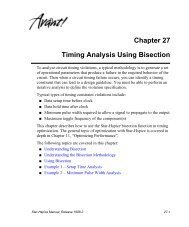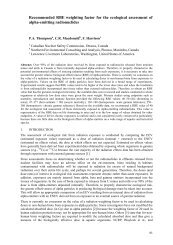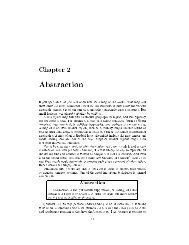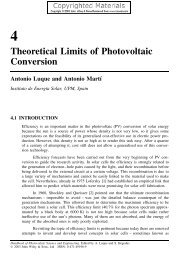A Brief Outline of the History of Technology - College of Engineering
A Brief Outline of the History of Technology - College of Engineering
A Brief Outline of the History of Technology - College of Engineering
Create successful ePaper yourself
Turn your PDF publications into a flip-book with our unique Google optimized e-Paper software.
A <strong>Brief</strong> <strong>Outline</strong> <strong>of</strong> <strong>the</strong> <strong>History</strong> <strong>of</strong> <strong>Technology</strong><br />
Revised 2 April 2013<br />
Summarized primarily from B. Bunch and A. Hellemans, eds., The Timetables <strong>of</strong> <strong>Technology</strong> (New York:<br />
Simon & Schuster, 1993).<br />
The stone ages (2,400,000 BC - 4,000 BC)<br />
Overview<br />
• natural, easily obtainable materials<br />
• simple processes (e.g. chipping)<br />
• earliest artifacts made <strong>of</strong> stone, but biological materials probably used earlier (no record)<br />
◦ nonce tools: used once and discarded (probably)<br />
◦ main tool was biface (hand axe)<br />
• evidence <strong>of</strong> aes<strong>the</strong>tic sensibilities: cave (and probably body) painting, jewelry, sculpture<br />
General<br />
1,000,000 BC South Africa First clear evidence <strong>of</strong> fire.<br />
Architecture & Construction<br />
1,900,000 BC Tanzania "Living floors" used as camps or home bases.<br />
400,000 BC France Oval huts provide shelter.<br />
Communications/Transportation<br />
30,000 BC Europe Tallies on bone, ivory used as records.<br />
12,000 BC Spain Paintings made in caves.<br />
8,000 BC Syria, Iran Fired clay tokens used as agricultural records.<br />
7,000 BC Sledges (sleds) used.<br />
4,300 BC France Oak canoes used on <strong>the</strong> Seine.<br />
4,000 BC Egypt Boats made from planks.<br />
Food & Agriculture<br />
18,000 BC Europe Cat domesticated.<br />
10,000 BC Switzerland Flax harvested, possibly for food.<br />
9,000 BC Persia Goats and sheep domesticated.<br />
8,750 BC Mexico Pumpkin domesticated.<br />
4,000 BC China Ard (primitive plow) used.<br />
Tools/Materials<br />
2,400,000 BC Tanzania Pebble tools manufactured.<br />
1,500,000 BC Africa Bifaces (hand axes) made.<br />
300,000 BC England Spears made.<br />
15,000 BC Japan Pottery made.<br />
15,000 BC Jordan Brick used to build houses.<br />
6,400 BC Turkey Copper melted and cast.<br />
The metal ages (4,000 BC - 1,000 AD)<br />
Overview<br />
• More complex processes<br />
• New sources <strong>of</strong> energy<br />
1
• Lots <strong>of</strong> developments besides metals: construction, writing, irrigation, ceramics, <strong>the</strong> wheel, sails<br />
• Emergence <strong>of</strong> civilization in several locations (apparently independently)<br />
• Occupational specialization: soldiers, merchants, traders, manufactureres, accountants, etc.<br />
• Large projects: pyramids, temples, canals, roads (possible due to large numbers <strong>of</strong> people<br />
ordered by kings)<br />
• Military technology <strong>of</strong>ten at <strong>the</strong> forefront <strong>of</strong> change: war chariots -> carts, battle axes -> plows<br />
• Long periods <strong>of</strong> inactivity punctuated by short periods <strong>of</strong> rapid progress (e.g., more progress after<br />
fall <strong>of</strong> Roman empire than during it)<br />
General<br />
3,500 BC Mesopotamia Sumer, <strong>the</strong> first civilization, established.<br />
3,000 BC Orient Early form <strong>of</strong> abacus developed.<br />
350 AD Turkey Public lighting used in Antioch.<br />
Architecture & Construction<br />
3,500 BC Iraq Ziggurats built with domes, arches, and vaults.<br />
2,600 BC Egypt Pyramids built as tombs.<br />
2,500 BC Egypt Dam built to catch rainwater.<br />
2,300 BC India Fired brick used for public buildings.<br />
1,000 BC Jordan Aqueducts built to supply city <strong>of</strong> Karcho.<br />
850 BC Turkey Arched bridge built.<br />
700 BC Israel Tunnel built as part <strong>of</strong> Jerusalem's waterworks.<br />
450 BC Greece Par<strong>the</strong>non built in A<strong>the</strong>ns.<br />
690 AD China Pagoda built <strong>of</strong> cast iron.<br />
Communication & Transportation<br />
3,500 BC Egypt Sailing ships used.<br />
3,500 BC Uruk Wheeled vehicles begin to replace sledges.<br />
3,300 BC Egypt Hieroglyphics written on papyrus.<br />
3,100 BC Uruk Traders use numbers.<br />
2,400 BC Mesopotamia Maps used for taxation.<br />
2,000 BC Crete Paved roads appear.<br />
2,000 BC Egypt Canal connects Lake Timsaeh to Red Sea.<br />
500 BC Greece Optical telegraph used for communication.<br />
300 BC Egypt Library <strong>of</strong> Alexandria established.<br />
170 BC Rome First paved roads built in Rome.<br />
700 AD Asia Earliest printed text, a Buddhist charm scroll, printed.<br />
Food & Agriculture<br />
3,000 BC Egypt Bag press used for extracting oil from olives, juice from grapes.<br />
3,000 BC Egypt Wooden plow used.<br />
2,300 BC Syria Horse domesticated.<br />
2,000 BC Seed drills made.<br />
1,900 BC Egypt Enormous irrigation project in <strong>the</strong> Fayum desert region.<br />
1,100 BC Rotary hand mill invented for grinding grain.<br />
1,000 BC China Several food preservation techniques used, including salting.<br />
500 BC China Farming practices include row planting, hoeing, fertilization.<br />
40 AD Rome Lake drained to make new farmland.<br />
60 AD Harvesting machine described by Pliny <strong>the</strong> Elder.<br />
100 AD China Insecticide made from powdered chrysan<strong>the</strong>mum flowers.<br />
Materials/Medical <strong>Technology</strong><br />
3,700 BC Egypt Bronze used.<br />
2
3,500 BC Mesopotamia Bricks fired in kilns.<br />
3,500 BC Egypt Iron used for ornamental and ceremonial purposes.<br />
3,300 BC Italy Clear evidence <strong>of</strong> everyday use <strong>of</strong> lea<strong>the</strong>r, wood, grass, etc.<br />
2,700 BC Egypt Bodies embalmed.<br />
2,500 BC Egypt Surgery practiced.<br />
2,000 BC Mesopotamia Perfumes developed.<br />
2,000 BC Egypt Glass produced, probably by accident at first.<br />
1,700 BC Egypt At least 700 medicines in use.<br />
600 BC Greece Marble used by sculptors.<br />
300 BC China Cast iron invented.<br />
250 BC Turkey Parchment invented.<br />
200 BC Italy Concrete used in <strong>the</strong> Roman town <strong>of</strong> Palestrina.<br />
140 BC China Paper used for clothing, packing material, personal hygiene.<br />
10 AD Italy Alcohol used for medical purposes.<br />
170 AD Italy Galen uses pulse as a diagnostic aid.<br />
400 AD China Steel made.<br />
850 AD China Gunpowder made.<br />
Tools & Devices<br />
3,500 BC Zambia Bow and arrow in use.<br />
3,500 BC Mesopotamia Potter's wheel invented.<br />
2,500 BC Masonry tools developed.<br />
2,000 BC Egypt Bow drill used to drill stone.<br />
2,000 BC Egypt Balance scales used.<br />
2,000 BC Assyria Looms used.<br />
1,600 BC Vietnam True plows made <strong>of</strong> bronze.<br />
1,500 BC Egypt Sundial developed.<br />
1,400 BC Egypt Water clock developed.<br />
1,050 BC China Magnetic compass developed.<br />
500 BC Persepolis La<strong>the</strong> in use.<br />
400 BC Catapults used.<br />
300 BC Screw invented (made by hand).<br />
250 BC Sicily Archimedes invents lever, o<strong>the</strong>r simple machines.<br />
250 BC Iraq Batteries used for electroplating.<br />
200 BC Gears developed.<br />
100 BC Yugoslavia Water-powered mills used for grinding grain.<br />
60 AD Egypt Steam engine developed but not used for practical purposes.<br />
The age <strong>of</strong> water and wind (1000 - 1732)<br />
Overview<br />
• Fall <strong>of</strong> Roman Empire led to deterioration <strong>of</strong> infrastructure: roads, bridges, aqueducts, postal<br />
services, currency, agricultural production<br />
• Standard <strong>of</strong> living returned to pre-Empire days: poverty, war, piracy, famine, epidemics<br />
• <strong>Technology</strong> began to re-emerge (technologies re-discovered): crop rotation, paved roads,<br />
steerable carriage, horse collars, horse shoes, waterwheel (becamse most important source <strong>of</strong><br />
power in N. Europe)<br />
• Christianty played major role in reintroductions <strong>of</strong> technology:<br />
◦ Christian monasteries played important role in revival: land clearing and cultivation, reintroduction<br />
<strong>of</strong> waterwheels to drive mills and o<strong>the</strong>r machines<br />
3
◦ Christian philosophy that labor was not degrading opened way to reintroduction <strong>of</strong> machines<br />
to help laborers<br />
◦ Christian rejection <strong>of</strong> slavery necessitated investment in labor-saving machines<br />
◦ Much artistic work done is service <strong>of</strong> Church: organs, bells, stained-glass windows,<br />
ca<strong>the</strong>drals<br />
• Artisans formed guilds: protected rights, established trade rules, trained apprentices (who later<br />
traveled and spread technology), but sometimes also discouraged innovation<br />
• Time <strong>of</strong> exploration and some innovation (Viking rudders)<br />
• Center <strong>of</strong> technology started in East (Chinese printing and gunpowder, Arab medicine, chemistry,<br />
and astronomy), spread to west<br />
• Gradual emergence <strong>of</strong> science as driver <strong>of</strong> technology<br />
• Hints <strong>of</strong> things to come: some pre-industrial factories, earliest assembly lines and<br />
interchangeable parts, patent laws, stock markets, printed books, knitting machines, experiments<br />
with steam<br />
General<br />
1087 England Survey taken to determine population (1.5 million)<br />
1436 Italy Interchangeable parts, assembly line used to build ships.<br />
1623 England Patent system established.<br />
Architecture & Construction<br />
1030 France Ca<strong>the</strong>dral <strong>of</strong> Notre Dame built in Chartres.<br />
1129 France Flying buttresses used in Abbey Church <strong>of</strong> St. Denis.<br />
1200 England Trusses used to support ro<strong>of</strong>s.<br />
Communication<br />
1048 China Movable type invented.<br />
1440 Germany Movable type re-invented by Gutenberg.<br />
1490 Europe First globe made.<br />
1513 Europe Atlas containing 200 maps published.<br />
1560 Switzerland Pencil in use.<br />
1590 England Newspaper published in London.<br />
1640 Germany Magic lantern invented.<br />
1727 Europe Reaction <strong>of</strong> silver salts to light discovered.<br />
Energy<br />
1100 Europe Windmills in use.<br />
1200 Scotland Coal mines in operation.<br />
1582 England Water turbine powers pumps to supply London with water.<br />
1629 Europe Steam turbine in existence.<br />
1690 England Steam-powered machine pumps water from coal mines.<br />
Food & Agriculture<br />
1070 Europe Horses used to pull farm equipment.<br />
1580 Europe Roller mill used to grind grain.<br />
1640 Europe Crop rotation practiced.<br />
1720 England Moldboard plow patented.<br />
Materials<br />
1340 Belgium Blast furnace developed.<br />
1380 Europe Cast iron becomes generally available.<br />
1660 England Natural gas discovered.<br />
4
Medical <strong>Technology</strong><br />
1260 Europe Spectacles used to correct farsightedness.<br />
1660 England Opium used to relieve pain.<br />
1701 Turkey Innoculation used to prevent smallpox.<br />
Tools & Devices<br />
1035 China Spinning wheel in use.<br />
1050 India (?) Construction <strong>of</strong> automata described.<br />
1280 Europe First mechanical clocks in use.<br />
1288 China First gun, a small cannon, made.<br />
1335 Compound crank invented.<br />
1400 Suction pump invented.<br />
1430 Europe Drive belt used to turn grindstone.<br />
1590 Italy Thermoscope, first primitive <strong>the</strong>rmometer, developed.<br />
1630 England Micrometer developed.<br />
Transportation<br />
1020 Turkey Improved shipbuilding practices (keel, frame, planks) in use.<br />
1086 China Magnetic compass in use for navigation.<br />
1396 Europe Steerable, four-wheeled cart in use.<br />
1500 China Scientist killed testing rocket-propelled flying machine.<br />
1620 England Submarine operated in <strong>the</strong> Thames.<br />
1630 England Wooden cart rails used in coal mines.<br />
The industrial revolution (1733-1878)<br />
Overview<br />
• appearance <strong>of</strong> factories led to significant social change<br />
• new sources <strong>of</strong> energy: coal-gas, steam, electricity<br />
• coal-gas lighting allowed large indoor factories, second and third shifts<br />
• emergence <strong>of</strong> engineering pr<strong>of</strong>ession (civil engineering first)<br />
• appearance <strong>of</strong> engineering school<br />
• organized resistance to technological change: Luddites<br />
General<br />
1733 Hungary First technical college established.<br />
1748 France L'homme machine by de la Mettrie, describes man as machine.<br />
1758 England Commission sets standards for length, weight, etc.<br />
1771 England Spinning factory built by Arkwright.<br />
1781 England Stopwatch timing used in effort to increase production.<br />
1809 Europe Arc light developed.<br />
1811 Germany Freiberg first city to be illuminated by gas light.<br />
1812 England Organized gangs called Luddites smash looms.<br />
1829 United States Term technology coined by Bigelow.<br />
Architecture & Construction<br />
1779 England Famous iron bridge built over Severn river.<br />
1792 United States First modern truss bridge built.<br />
1796 United States First modern suspension bridge built.<br />
Communication<br />
1774 Switzerland Electric telegraph built.<br />
5
1780 Fountain pen invented.<br />
1784 England First mail coach goes into service.<br />
1822 United States Typesetting machine invented.<br />
1824 France Braille invented.<br />
1835 Europe Photography invented.<br />
1843 Ada Lovelace describes Babbage's Analytical Engine.<br />
1866 Transatlantic telegraph cable laid.<br />
1868 United States First successful typewriter patented.<br />
1876 United States Bell patents telephone.<br />
1877 United States First phonograph built.<br />
Energy<br />
1831 Europe Direct current generator developed.<br />
1836 England First reliable battery developed.<br />
1855 United States Gasoline and o<strong>the</strong>r substances distilled from oil.<br />
1859 United States First commercial oil well drilled.<br />
1859 Europe First important internal combustion engine developed.<br />
1859 France First rechargeable storage battery invented.<br />
Food & Agriculture<br />
1784 Scotland Threshing machine invented.<br />
1793 United States Cotton gin invented.<br />
1800 Copper sulfate, o<strong>the</strong>r chemicals used to treat plant diseases.<br />
1804 France Canning used to preserve foods.<br />
1837 United States Steel plow invented.<br />
1857 France Refrigeration invented.<br />
1863 France Pasteurization invented.<br />
Materials<br />
1735 England Coke used to produce cast iron.<br />
1739 Europe Coal gas produced.<br />
1746 England Sulfuric acid produced.<br />
1839 United States Vulcanization <strong>of</strong> rubber discovered.<br />
1846 Italy Nitroglycerine discovered.<br />
1850 Rubber cement invented.<br />
1856 England Bessemer process for producing steel invented.<br />
1862 England Celluloid used to make items.<br />
Medical <strong>Technology</strong><br />
1736 First appendectomy performed.<br />
1751 England First mental institution opened.<br />
1756 Germany Cast models used to make false teeth.<br />
1774 Germany Hypnotism used to treat disease.<br />
1790 United States Dental drill invented.<br />
1800 England Chlorine used to purify water.<br />
1816 France Stethoscope invented.<br />
1842 United States E<strong>the</strong>r first used as a general anes<strong>the</strong>tic in surgery.<br />
1850 Germany Thermometer used as a diagnostic device.<br />
1865 England Phenol used as a surgical disinfectant.<br />
Tools & Devices<br />
1733 England Flying shuttle invented.<br />
1757 Hydraulic machine to power bellows patented.<br />
6
1766 Switzerland Electrometer invented to measure electric potential.<br />
1774 Commercially successful mechanical calculator invented.<br />
1787 Governor used to control speed <strong>of</strong> steam engines.<br />
1797 England La<strong>the</strong> slide rest developed.<br />
1803 Safety valves used in high-pressure boilers.<br />
1805 Europe Punch-card programmable loom invented.<br />
1818 United States Milling machine invented.<br />
1822 England Babbage invents his difference engine.<br />
1832 England Babbage invents his analytical engine.<br />
1835 United States Colt patents <strong>the</strong> revolver.<br />
1849 United States Safety pin patented.<br />
1851 United States Sewing machine patented.<br />
Transportation<br />
1759 England Shipboard chronometer developed to find longitude.<br />
1769 France Steam carriage built.<br />
1779 France First bicycle appears.<br />
1781 France Steamboat successfully tested.<br />
1783 France Hot-air balloon demonstrated.<br />
1797 England Iron rails used to carry horse-drawn wagons.<br />
1804 England Steam locomotive hauls 10 tons <strong>of</strong> iron on iron rails.<br />
1808 England Heavier-than-air machine carries human passenger.<br />
1815 Scotland Crushed rock used to pave roads.<br />
1838 Steamship crosses Atlantic.<br />
1845 Scotland Rubber tire invented.<br />
1854 United States Freight elevator demonstrated.<br />
1863 Europe "Horseless carriage" invented.<br />
The electric age (1879-1946)<br />
Overview<br />
• technology not confined only to large enterprises<br />
• major advances in transportation<br />
• new materials (plastics)<br />
• growth <strong>of</strong> automotive industry accelerated spread <strong>of</strong> technology<br />
• some new technologies not initially accepted (automobile, truck, farm tractor)<br />
• large electric networks (made possible by transformer) caused pr<strong>of</strong>ound changes in workplace<br />
(smaller faster machines, <strong>the</strong>rmostats, servomechanisms, automatic control, factories anywhere,<br />
numerous small workshops)<br />
• industrial research laboratories established (GE, Du Pont, Bell Telephone)<br />
• many advances due to WWII<br />
• technology became major part <strong>of</strong> everyday life<br />
General<br />
1896 United States Taylor uses time-and-motion studies to improve efficiency.<br />
1913 United States Ford introduces first true assembly line to manufacture cars.<br />
1945 United States First atomic bomb exploded.<br />
1946 Japan Statistical quality control used to revive Japanese industry.<br />
Communications<br />
1884 United States Linotype typesetting machine invented.<br />
1888 United States Sound motion picture patented.<br />
1888 United States Roll-film camera introduced.<br />
7
1893 Denmark First magnetic sound recorder developed.<br />
1894 Italy First radio equipment developed.<br />
1902 Germany Fax machine invented.<br />
1928 United States First television programs broadcast.<br />
1937 United States Xerography invented.<br />
Electronics & Computers<br />
1890 United States Punched card, electrically driven census system used.<br />
1904 England Vacuum tube patented.<br />
1927 United States Electromechanical analog computer developed.<br />
1937 England Turing machine conceived.<br />
1941 Germany First working, universal, programmable computer developed.<br />
1946 United States First all-purpose, all-electronic computer developed.<br />
Energy<br />
1882 United States First hydroelectric plant goes into operation.<br />
1892 France Diesel engine developed.<br />
1942 United States First nuclear reactor operates.<br />
Food & Shelter<br />
1879 United States First skyscraper built.<br />
1889 France Eiffel tower completed.<br />
1896 France Selective weed killers used.<br />
1897 United States Grape Nuts breakfast cereal introduced.<br />
1901 United States Internal combustion engine tractor introduced.<br />
1909 United States Electric toaster marketed.<br />
1913 Sweden Vacuum milking machine invented.<br />
1918 United States Home refrigerator introduced.<br />
1933 United States Construction starts on Grand Coulee Dam.<br />
1938 United States Self-propelled combine introduced.<br />
1939 Switzerland DDT used as insecticide.<br />
1945 2, 4-D used as herbicide.<br />
Materials<br />
1880 Para red, <strong>the</strong> first azo dye, invented.<br />
1898 United States High-speed steel developed.<br />
1906 Bakelite plastic invented.<br />
1927 Artificial rubber developed.<br />
1935 United States Nylon patented.<br />
Medical <strong>Technology</strong><br />
1896 United States First diagnostic X-rays taken.<br />
1923 France Tuberculosis vaccine developed.<br />
1935 Germany First sulfa drug used.<br />
1940 England Penicillin used as antibiotic.<br />
Tools & Devices<br />
1896 United States Grinding wheels with artificial emery go on <strong>the</strong> market.<br />
1904 Vacuum cleaners introduced.<br />
1916 United States First modern washing machine developed.<br />
1933 Germany Electron microscope built.<br />
1937 England Radar used to detect airplanes.<br />
Transportation<br />
8
1903 United States First successful airplane flies.<br />
1905 Germany First U-boat submarine launched.<br />
1908 United States Model T automobile goes into production.<br />
1914 Panama Panama canal completed.<br />
1914 United States Autopilot invented.<br />
1915 Germany First all-metal airplane built.<br />
1926 United States First liquid-fuel rocket launched.<br />
1927 First non-stop, solo, trans-Atlantic flight completed.<br />
1934 England Steamship Queen Mary launched.<br />
1935 United States DC-3 airplane introduced.<br />
1936 Germany First practical helicopter built.<br />
1939 Germany First jet aircraft flies.<br />
The electronic age (1947-1972)<br />
Overview<br />
• nuclear weapons caused fear that end <strong>of</strong> life on earth was possible and imminent<br />
• development <strong>of</strong> WWII inventions: materials (syn<strong>the</strong>tic rubber, plastics, syn<strong>the</strong>tic fuels), jet<br />
engines, rockets, missiles<br />
• rise <strong>of</strong> <strong>the</strong> automobile, decrease in rail passenger service, emergence <strong>of</strong> <strong>the</strong> suburb<br />
• increasing automation<br />
• split in workforce: specialize worker vs. unskilled worker<br />
• environmental problems: air, water, soil pollution<br />
• growing concern about society’s future due to environmental problems (Limits to Growth)<br />
• rise <strong>of</strong> <strong>the</strong> military-industrial complex<br />
General<br />
1948 United States 20 killed, 14,000 injured in Donora, PA from smog.<br />
1949 Murphy's Law conceived.<br />
1952 United States First <strong>the</strong>rmonuclear device exploded.<br />
1957 United States US Atomic Energy Commission launches Project Plowshare.<br />
1972 United States Club <strong>of</strong> Rome publishes Limits to Growth.<br />
Communications & Computer S<strong>of</strong>tware<br />
1953 United States Commercial color television broadcasting begins.<br />
1955 Precursor <strong>of</strong> <strong>the</strong> video terminal developed.<br />
1956 First transatlantic telephone cable goes into operation.<br />
1956 United States FORTRAN computer programming language developed.<br />
1906 United States First communications satellite launched.<br />
1970 United States Unix operating system developed.<br />
1970 United States MYCIN medical expert system developed.<br />
1972 International computer network established.<br />
1972 Word processing introduced.<br />
Electronics & Computer Hardware<br />
1948 United States Transistor developed.<br />
1950 United States SAGE computerized air defense system established.<br />
1951 United States Magnetic tape used to store computer data.<br />
1956 United States Magnetic disk used to store computer data.<br />
1958 United States Integrated circuit developed.<br />
1960 United States First transistorized large computer developed.<br />
9
1964 United States First successful supercomputer introduced.<br />
1965 United States First minicomputer introduced.<br />
1968 United States First integrated circuit-based computer introduced.<br />
1971 United States First microprocessor developed.<br />
1971 United States First pocket electronic calculator introduced.<br />
Energy<br />
1954 United States Photovoltaic cell developed.<br />
1954 Soviet Union First generation <strong>of</strong> electric power by nuclear reactor.<br />
Food & Shelter<br />
1953 United States Microwave oven developed.<br />
1955 United States Tractors outnumber horses for <strong>the</strong> first time.<br />
1958 United States First glass-walled skyscraper built.<br />
1972 United States DDT use restricted due to environmental problems.<br />
Materials<br />
1949 England Yarn produced from Dacron.<br />
Medical <strong>Technology</strong><br />
1952 United States Polio vaccine developed.<br />
1955 United States Tetracycline (antibiotic) developed.<br />
1956 United States Birth control pills used.<br />
1958 United States Pacemaker developed.<br />
1967 United States First (partially) successful human heart transplant performed.<br />
1969 United States First artificial human heart implanted.<br />
1972 England First computerized axial tomography scan introduced.<br />
Tools & Devices<br />
1948 United States First transfer lines used to manufacture engine blocks.<br />
1952 United States First numerically controlled machine tool developed.<br />
1960 United States First laser developed.<br />
1962 United States General Motors installs first industrial robots.<br />
1964 United States IBM develops first computer aided design system.<br />
1969 Scanning electron microscope used.<br />
1970 Carbon dioxide lasers used for industrial cutting & welding.<br />
Transportation<br />
1947 United States Bell X-1 is <strong>the</strong> first supersonic aircraft.<br />
1949 England The Comet, <strong>the</strong> first commercial jet aircraft, flies.<br />
1954 United States First nuclear submarine commissioned.<br />
1957 Soviet Union First artificial satellite launched.<br />
1961 United States Alan Shepard, Jr. is first astronaut.<br />
1961 Soviet Union Yuri Gagarin is first human to orbit <strong>the</strong> earth.<br />
1962 United States Mariner 2 becomes first space probe to reach ano<strong>the</strong>r planet.<br />
1967 Great Britain Torrey Canyon runs aground & spills 119,000 tons <strong>of</strong> oil.<br />
1969 United States First humans on <strong>the</strong> moon.<br />
1970 United States Boeing 747 jumbo jet carries 400 passengers.<br />
1971 Soviet Union Salyut 1 becomes <strong>the</strong> first space station.<br />
The information age and beyond (1973- )<br />
10
Overview<br />
• major developments related to information (computers, communication, genetic engineering, etc.)<br />
• information became new metaphor for reality<br />
• inherent belief that technology (especially information technology) will solve even <strong>the</strong> most<br />
difficult problems<br />
• information entrepeneurs (Jobs, Cray, Gates)<br />
• structure <strong>of</strong> organization reflected in its information systems<br />
• proliferation <strong>of</strong> computers (geographical and functional)<br />
• emergence <strong>of</strong> genetic engineering (new medicines, new organisms, altered organisms)<br />
• increased awareness <strong>of</strong> and response to environmental problems<br />
• environmental disasters: Three-Mile Island, Chernobyl, Bhopal<br />
• growing concerns about technology (Ellul, Postman, etc.)<br />
General<br />
1973 United States Field <strong>of</strong> genetic engineering born.<br />
1983 United States Strategic Defense Initiative started.<br />
1983 United States Nuclear winter predicted.<br />
1988 United States Genetically engineered animals patented.<br />
1989 United States Computer beats human chess master.<br />
Communications & Computer S<strong>of</strong>tware<br />
1973 United States Graphical User Interface developed for computers.<br />
1973 Voice recognition system developed.<br />
1973 United States Laser scanners used in a few supermarkets.<br />
1975 United States Laser printer introduced.<br />
1975 Great Britain Liquid crystal displays marketed.<br />
1977 United States Micros<strong>of</strong>t founded.<br />
1978 United States Speech syn<strong>the</strong>sizer developed.<br />
1979 United States First spreadsheet program for microcomputers developed.<br />
1980 United States Relational database program for microcomputers developed.<br />
1981 United States MS-DOS operating system developed.<br />
1983 United States First computer virus developed.<br />
1984 United States MacPaint graphic program developed.<br />
1985 United States First desktop publishing program developed.<br />
1986 United States Neural network computer developed.<br />
1990 World Wide Web created 1 .<br />
2004 YouTube invented 2 .<br />
Electronics & Computer Hardware<br />
1975 United States Altair 8800 microcomputer introduced in kit form.<br />
1976 United States First supercomputer with vector architecture introduced.<br />
1977 United States Apple II personal computer introduced.<br />
1981 United States IBM PC personal computer introduced.<br />
1984 United States Apple Macintosh personal computer introduced.<br />
1985 United States Massively parallel computer (16,536 processors) developed.<br />
1993 United States First all-optical computer developed.<br />
Energy<br />
1<br />
Anonymous, “Timeline <strong>of</strong> historic inventions,” Wikipedia,<br />
http://en.wikipedia.org/wiki/Timeline_<strong>of</strong>_historic_inventions.<br />
2<br />
Mary Bellis, “Modern Inventions,” About.com,<br />
http://inventors.about.com/od/timelines/a/ModernInvention.htm.<br />
11
1973 World Oil embargo imposed by OPEC.<br />
1979 United States Three Mile Island Unit 2 nuclear accident occurs.<br />
1981 United States 10 MW Solar power station completed.<br />
1986 Soviet Union Chernobyl nuclear accident occurs.<br />
1986 United States 4 MW geo<strong>the</strong>rmal power station completed.<br />
1993 United States Trojan nuclear power plant shut down ra<strong>the</strong>r than repaired.<br />
Food & Shelter<br />
1975 United States McDonald's replaces paper packaging with polystyrene.<br />
1988 United States Low-cholesterol eggs achieved.<br />
1990 United States McDonald's replaces plastic packaging with paper.<br />
1993 United States Genetically engineered tomato introduced.<br />
2004 Hungary Translucent concrete invented 1 .<br />
Materials<br />
1978 United States Chlor<strong>of</strong>luorocarbons banned for <strong>the</strong>ir role in ozone depletion.<br />
1984 India Thousands die from toxic gas release in Bhopal.<br />
1986 Switzerland Superconducting material discovered.<br />
1991 Diamond made from buckminsterfullerene at room temperature.<br />
Medical <strong>Technology</strong><br />
1973 Scotland Magnetic resonance imaging developed.<br />
1978 Great Britain First in vitro conceived baby born.<br />
1980 United States Genetically engineered human insulin tested.<br />
1984 United States First successful fetal surgery performed.<br />
1986 United States Gene for Duchenne muscular dystrophy discovered.<br />
1988 France RU-486 abortion pill introduced.<br />
1993 United States Virtual reality s<strong>of</strong>tware for human body dissection announced.<br />
1997 United State Viagra introduced 2 .<br />
2001 Self-contained artificial heart developed † .<br />
2001 Artificial liver invented * .<br />
2002 Birth control patch invented * .<br />
2003 Singapore Infrared fever screening system developed * .<br />
Tools & Devices<br />
1981 Scanning tunneling microscope detects individual atoms.<br />
1985 Lasers used to manipulate individual atoms.<br />
1988 United States Micromotor developed.<br />
Transportation<br />
1976 Europe Supersonic airliner service begins.<br />
1979 Europe Human-powered airplane flies across English Channel.<br />
1981 United States Reusable Space Shuttle launched.<br />
1981 France Regular high speed train passenger service begins.<br />
1985 United States Remote control submersible explore wreck <strong>of</strong> Titanic.<br />
1986 United States Space Shuttle Challenger explodes after launch.<br />
1986 France First fly-by-wire commercial aircraft flies.<br />
1993 United State Global Positioning System created * .<br />
2003 Japan Toyota Prius hybrid car introduced † .<br />
1<br />
Mary Bellis, “Modern Inventions,” About.com,<br />
http://inventors.about.com/od/timelines/a/ModernInvention.htm.<br />
2<br />
Anonymous, op. cit.<br />
12
Some More Recent Developments (in no particular order)<br />
• Google Gmail, Drive, Docs, Glass, Books, ...<br />
• Social media<br />
• 3D printing<br />
• Molecular manufacturing<br />
• Automated agriculture<br />
• Smartphones<br />
• Immersive visualization<br />
• Brain-machine interfaces<br />
• Autonomous vehicles<br />
• Human genome<br />
• Automated DNA sequencing<br />
• Gene <strong>the</strong>rapy<br />
• Genetically engineered foods<br />
• Human-like robots<br />
• Transhumanism<br />
• etc.<br />
13


